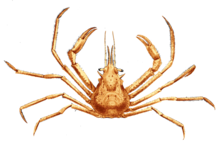User:Obsidian Soul/sandbox/Oregonia gracilis
| Graceful decorator crab | |
|---|---|

| |
| 1855 illustration of Oregonia gracilis by James D. Dana | |

| |
| Oregonia gracilis from California covered with sponges | |
| Scientific classification | |
| Domain: | Eukaryota |
| Kingdom: | Animalia |
| Phylum: | Arthropoda |
| Class: | Malacostraca |
| Order: | Decapoda |
| Suborder: | Pleocyemata |
| Infraorder: | Brachyura |
| Family: | Oregoniidae |
| Genus: | Oregonia |
| Species: | O. bifurca
|
| Binomial name | |
| Oregonia bifurca Dana, 1851
| |
| Synonyms[1][2] | |
| |
Oregonia gracilis, commonly known as the graceful decorator crab, is a species of crab belonging to the family Oregoniidae.[3]
Ontogeny[edit]
Graceful decorator crabs go through three larval stages, consisting of two zoeal stages and one megalopal stage. The two zoeal stages takes about four weeks to develop into megalopae after hatching.[4] Within the family Majidae, the zoeal stages of the graceful decorator crab closely resembles that of Pacific lyre crab (Hyas lyratus) and the tanner crab (Chionoecetes bairdi), and it may be difficult to distinguish between them.[5]

The first zoea has a carapace with three spines—a large dorsal spine and two relatively shorter lateral spines. At the front of the carapace is a long and thin rostrum. The carapace measures about 3.5 mm (0.14 in) in length from the tip of the dorsal spine to the tip of the rostrum. The first and second pairs of maxillipeds each have four swimming bristles (setae) on the exopods. The abdomen has five segments and ends in a forked telson. The second and third abdominal segments each have a pair of small spines extending sideways. A pair of spines extending backwards and sideways are also present in the third, fourth, and fifth abdominal segments; shorter on the fifth and long on the third and fourth. Each fork of the telson (furca) has three bristles on the inner side and small spines on the sides and on the upper surface.[4]
The second zoea is slightly larger than the first. The carapace is about 5 mm (0.20 in) in length from the tip of the dorsal spine to the tip of the rostrum. The first and second pairs of maxillipeds now have six swimming setae on the exopods. The abdominal segments is increased by one and has longer spines, otherwise the placement of the spines remain unchanged. Each furca of the telson now have additional fine bristles directed inwards. Developing pleopod buds are now present on the underside of the abdominal segments.[4]
The megalopa has a carapace about 3.3 mm (0.13 in) in length from the tip of the rostrum to the rear margin. At its widest point, it is about 1.3 mm (0.051 in) in length. The carapace now has a pair of spines facing forward and to the sides, a pair of spines in the middle of the back, a small pair of spines at the sides, and a long spine extending backwards. The appendages of the pereon (the maxillipeds and pereopods) now resemble the adult appendages. The second to the fifth pair of pereopods are walking legs, while the first pair is tipped with claws (chelate).[4]
The megalopae molt into adults upon reaching about 9 to 11 cm (3.5 to 4.3 in) in length for males, and 8 to 10 cm (3.1 to 3.9 in) in length for females.[6]
References[edit]
- ^ Rathbun, Mary J. (1925). The Spider Crabs of America (PDF). Bulletin (United States National Museum) 129. Washington: Government Printing Office. pp. 71–79.
- ^ Davie, P. (2012). "Oregonia gracilis Dana, 1851". WoRMS. World Register of Marine Species. Retrieved September 3, 2012.
- ^ Cowles, Dave (2005). "Oregonia gracilis Dana, 1851". Walla Walla University. Retrieved January 11, 2012.
- ^ a b c d Puls, Amy L. (2001). "Arthropoda: Decapoda". In Shanks, Alan L. (ed.). An Identification Guide to Larval Marine Invertebrates of the Pacific Northwest (PDF). Corvallis, Or.: Oregon State University Press. pp. 241–242. ISBN 9780870715310.
- ^ Fisher, Jennifer L. (2006). "Seasonal timing and duration of brachyuran larvae in a high-latitude fjord" (PDF). Marine Ecology Progress Series. 323: 213–222. doi:10.3354/meps323213.
- ^ Duff, Cameron (1999). "Oregonia gracilis: Decorator Crab". Evergreen State College. Retrieved September 5, 2012.
